DMM UNI-T UT191T
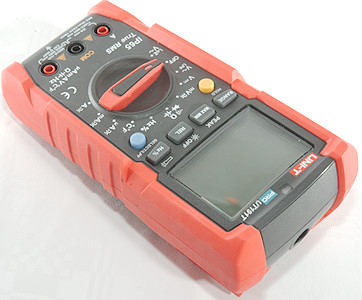
This is a industrial grade DMM designed for electricians. This series has two versions E without temperature and T with temperature, this is the T version.

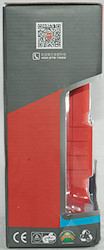
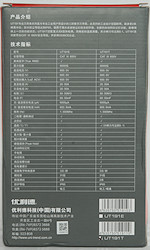
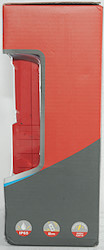
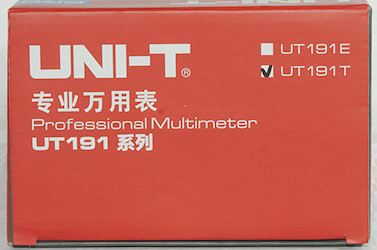
I got it in a retail box where the meter is very visible (It is covered by shaped plastic).

The box contained the meter, a pair of probes, a thermocoupler, a manual and a pouch.
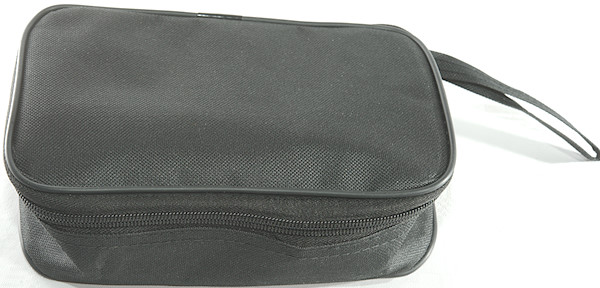
Everything fits in the pouch.



Probes are branded UNI-T and rated for 20A, they have very low resistance and the 20A rating looks good enough.
With a tip cover they are CAT IV 600V or CAT III 1000V, without CAT II 1000V (This is fairly standard for probes).
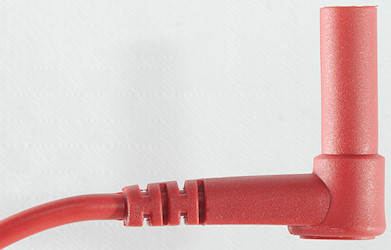
The plugs are fully shrouded, but the shroud is a bit short


The thermocoupler has a 3 pin plug that fits into the meter, it will also fit other meters with the input terminals in line.
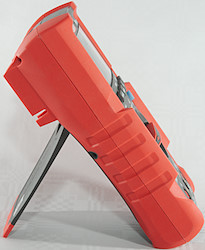
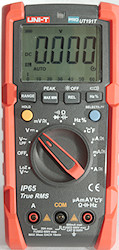
The meter is fairly heavy and the range switch easy to turn, this means it can easily be used with one hand, either lying flat or standing.
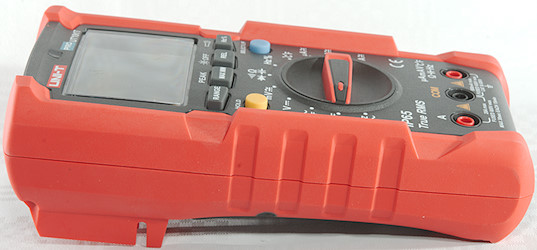
All the red plastic is slightly rubberized in feel including the range switch.
The red plastic works as bumpers from any direction.
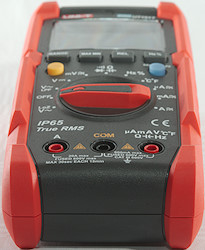
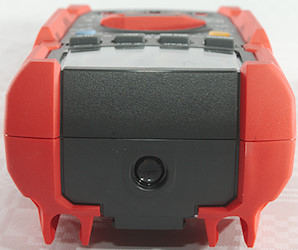
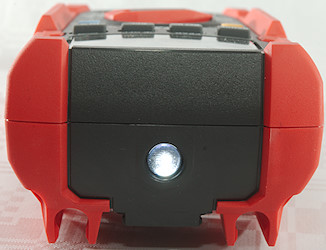
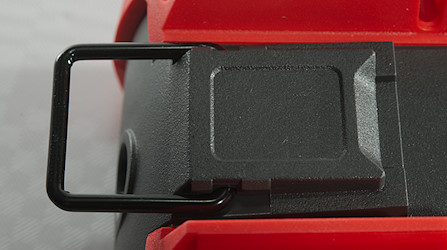
The flashlight led and a hanger.
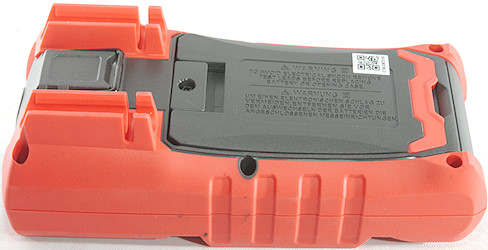
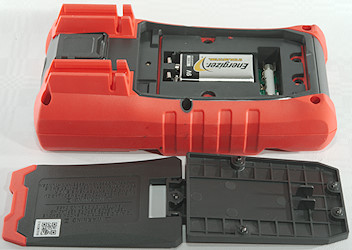
There was five screws to hold the battery cover
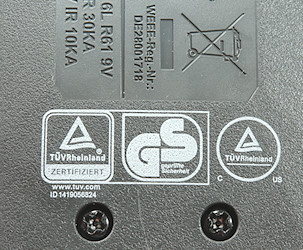
These marks is a good indication that the meter passes the CAT test.
Display
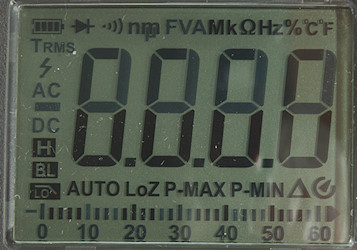
All the segments are shown during power on.
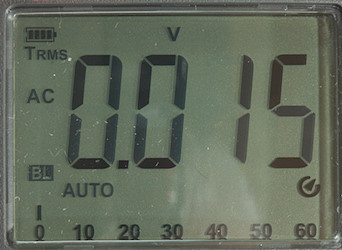
Typical display during usage, it will show the number and selected measurement
Functions
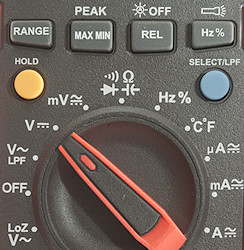
Buttons:
- Range: Select manual range and change range, hold down to reactivate automatic ranging (Hz and C is always auto).
- Max/min: Capture maximum and minimum values, it will change between max/min, bargraph will show actual value. Hold down to disable.
- Rel: Shows values relative to current value, will also select manual range. Press again to disable. Hold down to turn backlight off until next power cycle.
- Hz %: Show frequency and duty cycle in AC voltage and current ranges, in Hz mode it will select duty cycle. Hold down to turn flashlight on.
- Hold (Yellow): Will freeze the display reading, until pressed again.
- Select (Blue): Select DC/AC in mV and current modes, continuity, diode, capacitance in ohm mode, LPF in VAC and can also be used to show duty cycle in Hz mode. The actual selection is remembered when changing range or turning power off.
Max/min and REL always select manual range.
Rotary switch:
- LoZ: Low input impedance (300kOhm), range is always 600VAC.
- Off: Meter is turned off
- VAC: AC voltage with or without LPF (Low Pass Filter). It is possible to select Hz.
- VDC: DC voltage.
- mV: AC or DC milli volt, it is possible to select Hz in AC mode.
 : Ohm, capacitance, diode and continuity.
: Ohm, capacitance, diode and continuity.
- Hz: Logical frequency input.
- °C °F: Temperature, use SELECT for Celsius or Fahrenheit
- uA: Micro ampere DC or AC, it is possible to select Hz in AC mode.
- mA: Milli ampere DC or AC, it is possible to select Hz in AC mode.
- A: Ampere DC or AC, it is possible to select Hz in AC mode.
Input
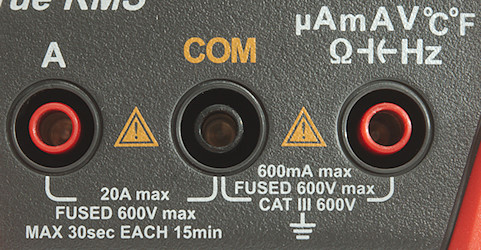
- A: 20A current input.
- COM: The common terminal for all ranges.
- xxx: All other ranges, including uA and mA
Measurements
- Volt and frequency
- MilliVolt ranges remembers last AC/DC setting.
- 1V AC readings is 5% down at 2kHz, rms will not work at that frequency
- 7V AC readings is 5% down at 800Hz when LPF is active, rms will not work at that frequency
- At 0.1Vrms ACV frequency range is from 2Hz to 2.5kHz
- At 1Vrms ACV frequency range is from 1.1Hz to 30kHz
- AC frequency requires a zero crossing.
- Frequency input do not require a zero crossing and handles at least +/-9.8V offset at 0.1VAC.
- At 0.1Vrms frequency input range is from 1.1Hz to 1.1MHz
- Duty cycle works from 20% to 80% at 100kHz with 1Vpp, precision is within 2.0.
- Duty cycle works from 1% to 99% at 100kHz with 4Vpp, precision is within 0.1.
- Max/min needs about 380ms to capture a repeating voltage max, autorange is disabled when using this function.
- Peak can only be selected in AC V and mV will capture a maximum in less than 0.2ms, but it may be 20% to high. The values captured are DC values.
- Input impedance is 10-11Mohm on DC and AC
- mVDC is high impedance up to about 2V where it drops to about 20kOhm, above 14V it will drop to 3kOhm
- mVAC is the same, but capped by a 10MOhm resistor.
- Frequency input is 10Mohm
- LowZ is constant 300kOhm input impedance and is locked in 600VAC range.
- Input protection is 600VDC/600VAC
- Current
- 20A range has audible alarm above 10A
- Current ranges each remember AC/DC settings.
- 20A range is fused with a 11A/1000V 10x38mm fuse
- mAuA range is fused with a 0.6A/600V 6.3x32mm fuse
- Peak can be selected in AC.
- Ohm, continuity, diode and capacitance
- Ohm needs about 2.8s to measure 100ohm
- Ohm voltage is 1.0V open and 0.33mA shorted.
- Continuity is very fast (less than 5ms).
- Continuity beeps when resistance is below 50ohm.
- Continuity is 1.0V open and 0.33mA shorted
- Diode range uses 3.2V, max. display is 1.200V at 0.86mA, max. current is 1.4mA shorted
- 10uF takes about 2.5 seconds to measure.
- 11000uF takes about 6.5 seconds to measure.
- Overload protection is 600V
- Miscellaneous
- Current consumption of meter is 2.2 to 3mA (44mA with flashlight, 62mA with background light, max. is 100mA).
- Display starts fading around 3.4V and is gone at 2.2V, battery symbol shows empty at 6.2V.
- Readings will be correct until the display is faded.
- Backlight and flashlight starts fading at 4V and is gone at 2.7V
- Viewing angle is good
- Display updates around 3 times/sec
- Bargraph updates at same speed as display.
- Backlight will automatic turn on when in dark surroundings
- Flashlight will not turn off automatic, but turns off with the auto power off.
- Will automatic turn power off in about 16 minutes.
- Standard probes cannot be fully seated in the meter, but they do connect.
- The meter usual need a few display update to before it display the value.
- Weight is 441g without accessories, but with battery.
- Size is 180 x 87.5 x 55.5mm
- Probes
- Probe resistance 15mOhm for one, that is very low.
- Probe wire are 79cm long and feels a bit stiff, probably due to the thickness.

A look at the capacitance measuring waveform with a 1uF capacitor.

Frequency input is constant 10Mohm resistance.

mVDC is high impedance up to about 2V.

Tear down
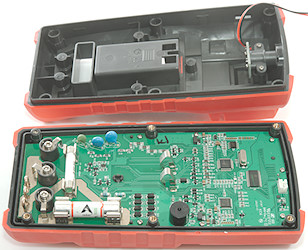
To open the meter I fist had to remove the battery (5 screws), then I could remove the back cover (6 screws). All the screws are captivated in the covers.
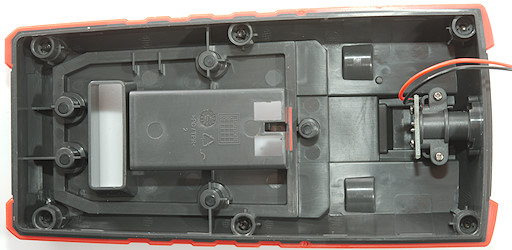
The back cover with the flashlight.
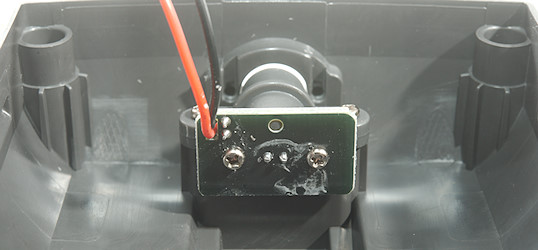
A small circuit board for the led.
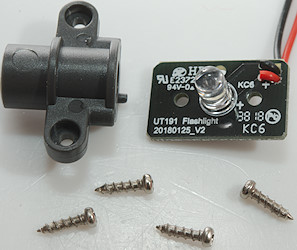
The led is a ordinary 5mm type.
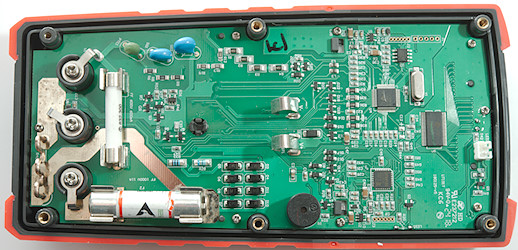
With the back cover removed there is access to the 11A fuse.
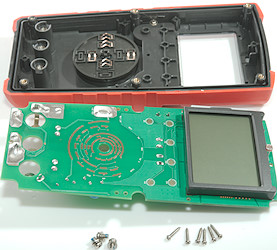
To get the circuit board out I had to remove the 3 screws from the terminals and 6 screws from circuit board.
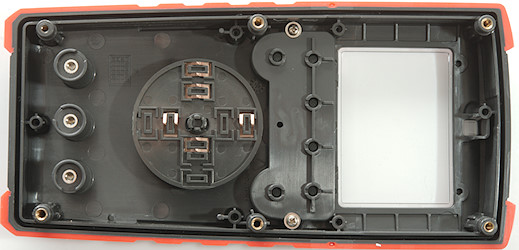
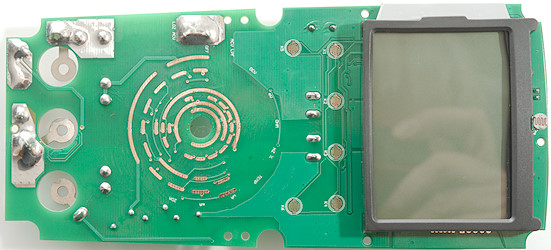

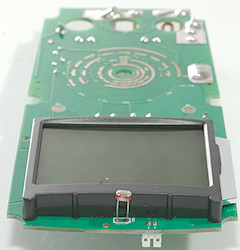
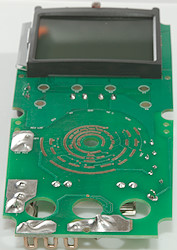
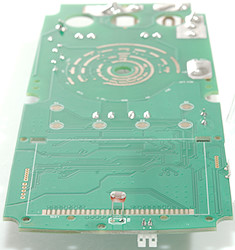
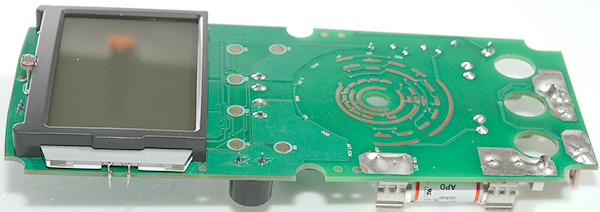
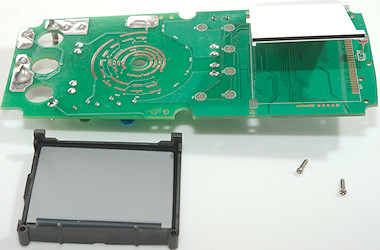
To get the display of I had to remove two more screws. The backlight is soldered to the circuit board.
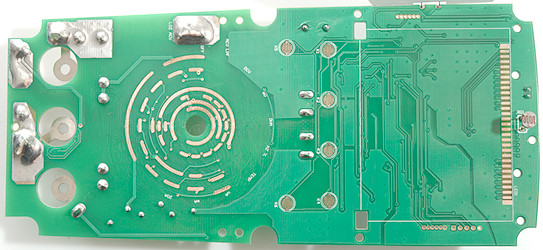
This side of the circuit board only holds the LDR for the automatic backlight.
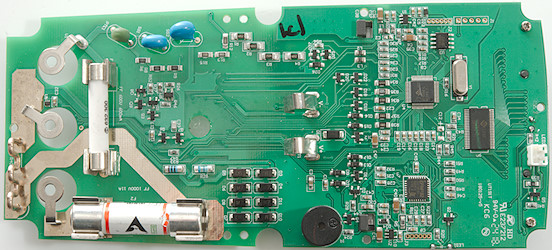
The 20A current shunt (R40) is moderate in size and has a nice big fuse. The uAmA range uses two shunts (R33: 1ohm, R28: 99ohm) with separate diode protection for each (D7, D8, D10, D11 for R33 and D3, D4, D5, D6 for R28).
The voltage input has 3 paths: High impedance (R1, R2, R3, R4: 4x2.5Mohm), medium impedance (R12, R13, R15: 3x300kOhm) and low impedance with protection (PTC1: WMZ12A: 250VAC & SG1, SG2: 2x07D681K: 680V), this path also has a medium impedance line (R6, R8, R9: 3x100kOhm), this is used for LowZ mode. In mV a transistor pair (Q8 & Q9) add protection to this path. In ohm it is another pair (Q1 & Q3) and in temperature it is the third transistor pair (Q6 & Q7). For temperature there is a temperature sensor near the input terminals (U6: OBS -> TMP112) and a OpAmp (U5: OAXQ -> OPA333) to amplify the thermocoupler signal.
There is a diode (D1) near the battery + input terminal, this means that a wrongly inserted battery will not damage the meter.
Most of the diode collection (D9, D12, D13, D14, D15, D16, D17, D18, D19, D20, D21, D22, D25, D26, D27) is probably coding of the range switch for the multimeter IC (U5: DTA0661L), this chip also has a calibration storage (U3: 24C02A).
There is a microprocessor (U7: EFM32ZG210F32: ARM M0 32k flash, 4k ram) and a display driver (U6: HY2613B).
The power supply is handled by two chips (U1 & U2: marked SX81C).

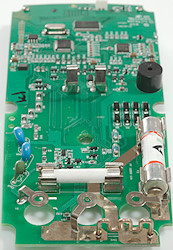
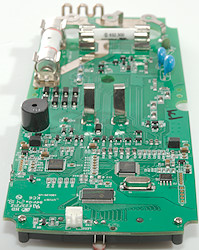
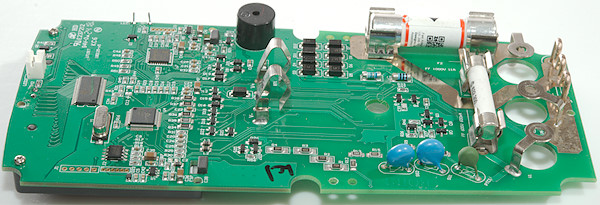
Conclusion
The protection is not perfect (A single PTC without series resistor is on the low side to handle a transient), but it must have passed the CAT test .
This meter has a broad selection of ranges and functions for a standard multimeter with the addition of LowZ, min/max/peak and flashlight. With the limited input bandwidth the LPF is not that important. The automatic backlight looks like a useful feature. The temperature sensor near the input terminals is a nice feature.
I am missing higher diode voltage display, but at least it can turn leds on. The peak is fast, but not very precise.
Notes
UNI-T do often make rebranded meters, i.e. it may exist with other names on it.
How do I review a DMM
More DMM reviews
 : Ohm, capacitance, diode and continuity.
: Ohm, capacitance, diode and continuity.



























 : Ohm, capacitance, diode and continuity.
: Ohm, capacitance, diode and continuity.
























